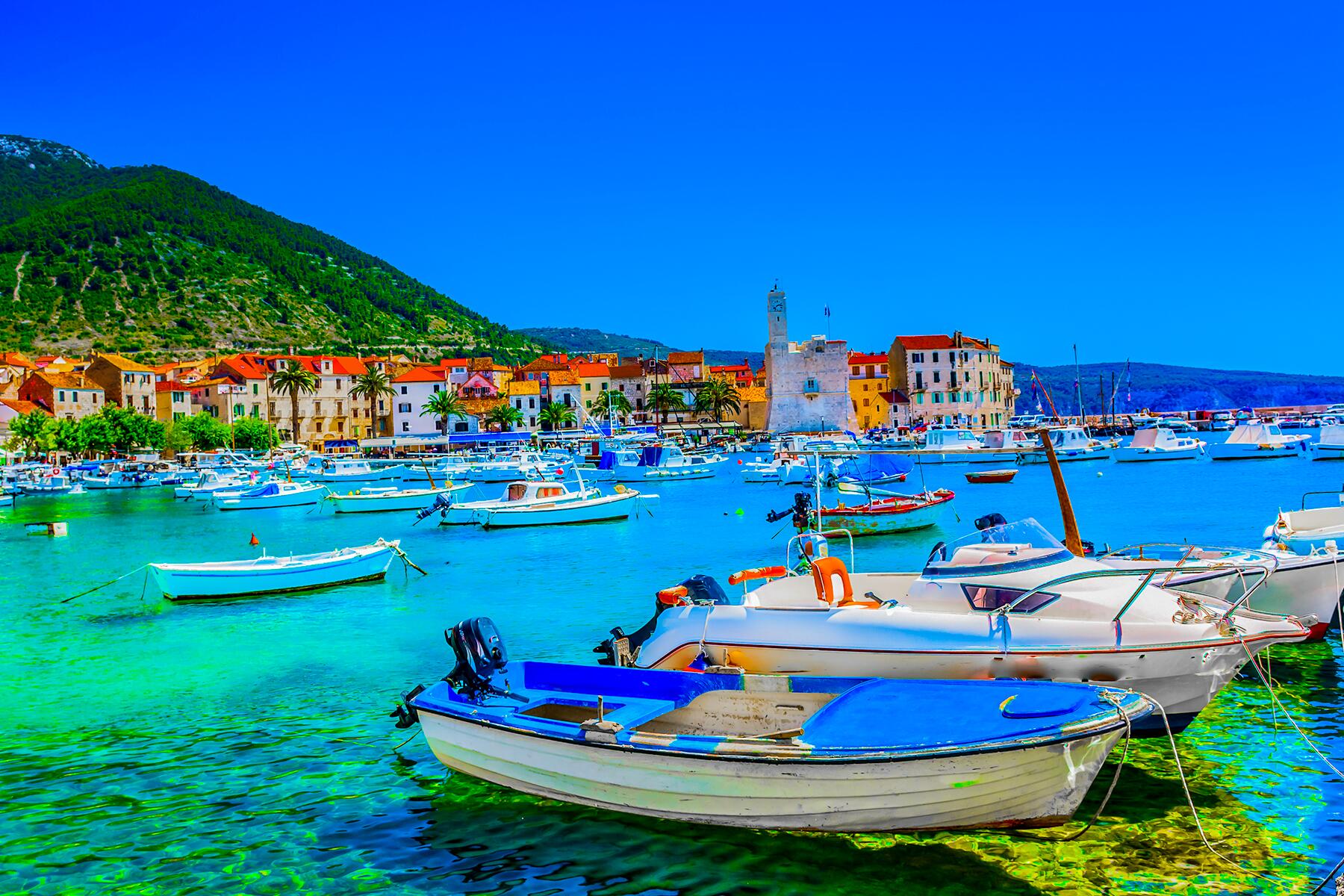Forget the milk and cookies. Croatia's far-flung island, Vis, sets fire to a ship for the jolly saint of sailors.
F
lames light up the mountainside above Komiža’s port. On Vis, Dalmatia’s western island, a traditional wooden boat burns every December. This centuries-old ceremony is partially a nod to the ancient idea of living boats–a ship is born with a christening and dies with this funeral pyre. But this fire is also tied to the modern symbol of Christmas, the miraculous man and alleged home invader himself. Jolly old Saint Nick protected sailors and travelers long before he started delivering toys. Vis residents, still intimately connected with the sea, continue to thank the famously generous patron saint for his year-round job.
It’s no coincidence that traditions survive on Croatia’s cherished and remote island. Geography and history have protected it from rapid change and mass tourism. A World War II allied air force base and then Yugoslavian military post, craggy Vis was off-limits even to most Croatians for decades.
Distance and seasonally gnarly winds still keep the country’s crowded tourist trail away. Persistent travelers enjoy airfields turned wineries, tunnels that hid submarines, a pristine glowing blue ocean cave, and the undeveloped cliffs of one of Europe’s most loved hidden beaches.
But Vis is more than an action-packed island. Whether you brave the weather for hyperlocal experiences like the St. Nicholas ceremony or show up for adventure on sun-drenched days, here’s how to explore the history and authenticity that makes Vis so special.
Recommended Fodor’s Video
Sea, Fire, and a Saint
December is not the first choice for most of Vis’s visitors. But those that make it can witness a ceremony rooted in ancient beliefs. And as modern metal replaces the traditional wooden boats, this gratitude ritual may disappear along with the ships it burns.
Saint Nicholas is the Catholic and Orthodox Christian patron of children, travelers, and sailors. On tour with lifelong Vis resident Goran Miletic of Alternatura, Miletic explains the essential connection for an island that has been a strategic maritime port for over a thousand years.
“We are Catholics, 127% Catholico,” Miletic laughs. Pope Alexander III dedicated the church of St. Nicholas in 1117. The saint’s protection extends not only to the hundreds of Vis fishing boats that plied the waters but also to defend the island from attacks.
“Our Lady of pirates,” says Miletic of the story of the painting of the Virgin Mary that was carried off twice by pirate ships, only to have the vessels sink and the artwork float back on a wave.
On December 6, it’s time to honor their protector. Hopeful fishing boat owners wait for their name to hit the top of the list when their old boat will have the sacrificial honor. On the eve of the saint’s feast day, Komiža residents march the ship from the beach to the 10th-century church above the town.
Early the next morning, the town gathers, and the boat’s owner sets it alight. Residents each contribute wood to the bonfire and finish with songs and a processional before mass. The boat burns throughout. Priests then use the ashes to bless other ships’ safety.
While Santa Claus brings toys to children around the world the night before Christmas, traditionally, the children of Komiža get another memorable visit. The night before the boat’s bonfire, St. Nicholas delivers apples underneath their pillows.
As the art of traditional shipbuilding is disappearing, the ability to continue to burn wooden vessels while also protecting the boats themselves remains a balancing act. The Gajeta Falkuša Heritage Project brings attention and education to continue the future of the island’s classic ships that once dominated the Adriatic.
Adriatic Authenticity
Captains across Croatia have Vis at the top of their list. Komiža’s shelter from the northern wind and the dozens of peacefully secluded bays and coves draw them in. Yet this favored spot of sailors also symbolizes the region’s proud mariner heritage.
The port in the town of Vis is one of the oldest in the Adriatic sea. Since the Ancient Greeks, empires have tried to conquer and control this key strategic point. All around the island, you can find remnants of the Roman and Austro-Hungarian empires, the Venetian Republic, and British influence from World War II.
Croatians from the Dalmatian coast speak about Vis wistfully, repeatedly hailing its authenticity. “Vis is one of the most important places to see what Croatia has to offer, especially from the sea,” says Antonio Gojak, captain of the Andi Star. Gojak highlights the traditional techniques that Komiža’s famed fishermen still use and the dominance of classic stone architecture. Locals and visitors still mix at the bars, a sure sign to Gojak that the region’s renowned hospitality endures.
“Vis is one of the places still intact even with tourism,” says Gojak.
Miletic and the island’s other 3000 residents hope to keep it that way. The sharp-sailed historical falkuša ships are now classified as national cultural intangible goods. Vis holds UNESCO Archipelago GeoPark status.
“Tourism has only been a part of Vis for the last 22 years. We base our tours on interpreting and protecting the natural and cultural heritage. In very fun ways,” says Miletic.
Adventure on Vis
Even if you don’t make it for the St. Nicholas Feast Day flames, Vis offers up everything its mountainous 34 square miles has from April to October. Summer months are the best time to get out on the water, but the Adriatic is still just a brisk swim as late as October.
If you jump in anywhere, the cliff-wrapped pebble beach at Stiniva is a clear winner. It’s a steep hike to the short beach, but hired boats also anchor near the cliff gates. The thrill of swimming through the 16-foot gap in the cliffs into the aquamarine cove can give you goosebumps even in warm water.
Guided tours keep watery wonders coming. Set sail on the traditional falkuša in an ecologically sustainable adventure that takes you back to the 16th century. Duck down and shoot through a seemingly impossible tiny rock opening into the iridescent glow of the Blue Cave. Treasures stack below Vis’s waters, and you can snorkel and dive at Roman archeological sites, centuries of shipwrecks, downed warplanes, and soothing grottos.
Back on land, military tours come with a twist. Drink wine near a World War II refueling airfield. A hidden, almost 400 feet submarine tunnel is a unique spot for a swim. Navigate a labyrinth of abandoned military tunnels under this seemingly benign island.
Diverse hikes, paragliding, and caving fill your days. Just don’t forget to embrace the Dalmatian island life like a local by giving into another favorite Dalmatian tradition, fjaka, or the sleepily chill state of doing nothing.





